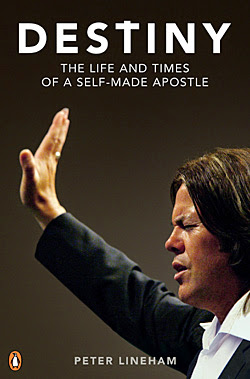 With his taste for sharp suits and powerful motorcycles, Bishop Brian Tamaki has an interestingly polarising effect on the average Kiwi.
With his taste for sharp suits and powerful motorcycles, Bishop Brian Tamaki has an interestingly polarising effect on the average Kiwi.
Let me make it clear before I go any further that I have no particular bias for or against any church – my religious views are my own and I don’t feel the need to share them with anyone. In fact, I find those with strong opinions on either side of the debate who feel the need to try to ram their own beliefs down my throat intensely annoying: I don’t care if you believe in God or if you are an atheist, just don’t feel compelled to try to force me to adopt your views.
I do certainly find some of Destiny’s policies distasteful but this review is based solely on the content of the book, not on the religion.
Massey University associate professor of history Peter Lineham has drawn on his knowledge and research on religion in New Zealand’s life and history to present a picture of a self-made and self- proclaimed apostle who has built a church from the ground up.
Having already had works published on the subject of religion – including Bible & Society, There We Found Brethren and No Ordinary Union – Lineham is probably more qualified than anyone in New Zealand to take an objective look at Bishop Tamaki and his Destiny church.
The Pentecostal fundamentalist Christian movement began back in 1998 but it was the “Enough is Enough” march of 2004 that proved a catalyst for the mega- church’s rock’n’roll rise to fame and put the spotlight squarely on the charismatic Bishop Tamaki.
Things seem to have quietened down over the past year or so but, for a while, it was near impossible to go a day without reports of some fresh controversy involving the church or Bishop Tamaki himself. Sometimes both. There were allegations of it being a cult, the members who marched in the “enough is enough” rallies were likened to Nazi storm troopers and there were many raised eyebrows over Bishop Tamaki’s lavish vision for his flock.
The church grew at an incredible pace, going from just 20 members in 1998 to more than 5000 at its peak in 2003. And there was plenty of sniggering when Bishop Tamaki was declared a bishop but I suppose that’s pretty much how most religions have been created over the years: some dude takes it upon himself to be the head honcho and at some point gives himself the appropriate title. It just normally doesn’t happen at such a break-neck pace.
I find it difficult to get behind the policies and views of the Destiny church – particularly those that equate to lesser rights for some citizens – but that doesn’t mean I can’t appreciate the success story it became: if this was the story of someone who had built a business with the same level of success and appointed himself CEO or Grand Poobah, we’d all be patting him on the back and feeling a sense of Kiwi pride.
Cited as the first full and independent account of the church and its personnel, this book is a fascinating look behind the hype and flash suits, resulting in a revealing picture about the man and the movement.
